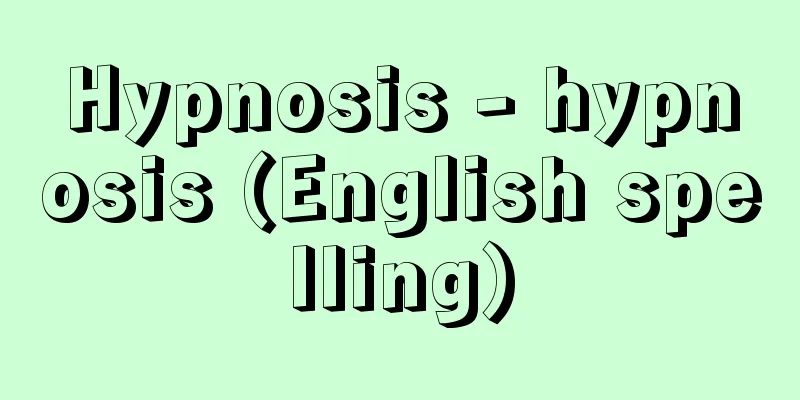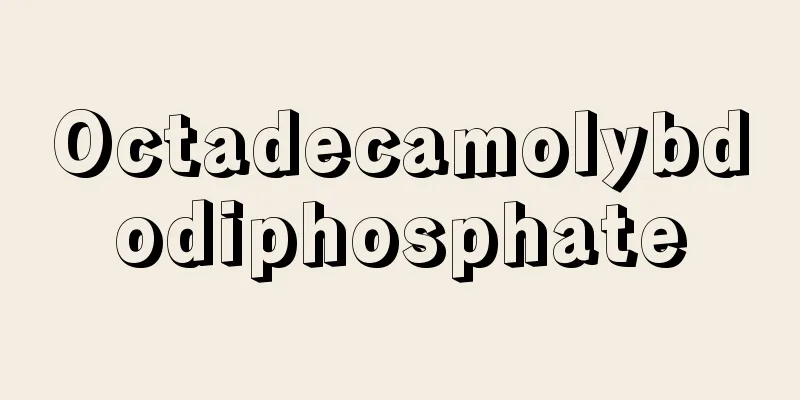Hypnosis - hypnosis (English spelling)

|
The procedure known as hypnosis produces unusual physical and mental phenomena not normally seen. In particular, changes are seen in psychological activities such as consciousness, movement, memory, perception, thinking, and imagery, as well as physiological activities such as brain waves, electromyograms, the gastrointestinal tract, the circulatory system, and the autonomic nervous system. It is believed that the reason these hypnotic phenomena occur is because the person's mind and body are in a unique state that is different from normal, and this is called the hypnotic state. Hypnosis usually refers to this hypnotic state, but it can also refer to the unique mental and physical phenomena that occur in this state. The hypnotic state is also called trance, and although it resembles sleep, on closer examination it should be clearly distinguished from sleep, both psychologically and physiologically, and is more similar to the mental and physical phenomena that occur during wakefulness. It was once thought to be something seen in people with mental disorders, but it is now considered to be not a psychopathological phenomenon, but rather a phenomenon that can be artificially induced in anyone. It is just that the movements and mechanisms of the mind and body that are rarely seen in normal life tend to appear in an expanded and emphasized form. [Naruse Satosaku] HypnosisThe technique for inducing hypnosis, i.e., the hypnotic method, is composed of a series of suggestions, starting with motor suggestions that anyone can easily respond to, followed by sensory suggestions related to the five senses, and then more specific suggestions such as memory suggestions and personality suggestions, until the subject naturally falls into a hypnotic state. This procedure is called hypnotic induction suggestion. The resulting hypnotic state is called a trance, and a different alteration of consciousness is observed from that observed in normal wakefulness, the subject's intentional attitude toward the outside world and reality becomes weak, and the subject's mind is directed toward the subjective and inner world, imagination and imagery become more active, suggestibility becomes abnormally high, and the subject becomes absolutely dependent on the hypnotist, i.e., the person performing the hypnotic method. [Naruse Satosaku] historyHypnosis was established as a science around 1770, but it has been practiced for a much longer time, since prehistoric times, and it can be said that it has been with mankind throughout history, and has been familiar to all peoples in all parts of the world. Most of it was used in religious ceremonies, medical settings, politics, and trials. In religious ceremonies, hypnosis is often used in mediumship or shamanism, where the person is induced in a certain way by a priest or monk, or enters a state of ecstasy by concentrating their thoughts on themselves and communicates with gods or spirits. It is said that hypnotic induction was effective in treating illnesses in the ancient Egyptian temples of sleep. Primitive shamanistic hypnosis was linked to prophecy and medicine, and continues to this day in the form of Korean shamans, Japanese miko, and yuta, as well as in the Siberian Eskimo, Native Americans, various parts of Africa, and the Indonesian island of Bali. Celtic priests would repeat spells to put the fortune teller into a trance, giving the fortune teller a vision of who should be the next king or predicting the fortunes of events. In Japan, there are records of shrine maidens being used to predict who should be the next Minister of the Left. Even in the late 19th century, defendants were said to be put into hypnosis in Western courts to make them tell the truth. When scientific hypnosis first began, F. A. Mesmer was famous in France, and James Braid (1795-1860) was famous in England, so hypnosis often appears in novels under names such as Mesmerism or Braidism. The word hypnotism was also used for a long time in England, but after World War II, the American Society of Clinical and Experimental Hypnosis decided to abandon this term and use hypnosis, and since then, this has been widely followed internationally. [Naruse Satosaku] the studyHypnosis is not a single phenomenon, but rather a complex and very subtle phenomenon of human mental and physical activity, so many great scholars have developed their own new methods and theories by focusing on certain special aspects of hypnosis. Because emotional expression is strong during hypnosis, Freud focused on cathartic therapy and developed theories and methods of psychoanalysis. It was during hypnosis research that Janet became aware of the unconscious and that Theodore Rey Sarbin (1911-2005) developed the idea of role theory, a form of social psychology. Hypnosis research can be divided into the following three phases. (1) The various phenomena that occur before the hypnotic state is induced, especially the process of internal and psychological changes in the subject These can be further divided into experimental research and clinical research. Psychological research on perception, memory, movement, thinking, personality, etc., and physiological research on electroencephalography, electromyography, the circulatory system, and the autonomic nervous system belong to the former. Clinical research includes psychotherapy (psychotherapy) first and foremost. This is because the characteristics of hypnosis make it easier to proceed with various existing psychotherapies than during normal wakefulness. Even counseling is performed during hypnosis. Both psychoanalysis and behavioral therapy are known to be effective during hypnosis. These involve the hypnosis of others, but self-hypnosis can also be used. Examples include the autogenic training method of Johannes Heinrich Schultz (1884-1970) and the self-control method of Gosaku Naruse (1924-2019). [Naruse Satosaku] useEven in modern medicine, which is based on physiology, psychological conditions cannot be ignored, and psychological conditions have become more and more important. In particular, since 1963, when psychosomatic medicine, which is based on the study of mind-body correlation phenomena, was launched in Japan, various hypnosis-related therapies, including self-hypnosis and other-hypnosis, have been used to treat various symptoms called psychosomatic disorders, mainly in internal medicine, and autogenic training, a type of self-hypnosis, has also become widely used. Since the feeling of pain is greatly influenced by psychological conditions, hypnosis has been used for controlling pain since ancient times, and it continues to be used in tooth extraction, cutting, and other dental procedures, painless childbirth, morning sickness, menstruation, breast milk secretion, and other gynecological symptoms. Furthermore, since around 1970, research on hypnotic analgesia, which reduces pain through hypnosis, has been actively conducted again in surgical operations, including for terminal cancer patients. Furthermore, since 1966, hypnosis has been uniquely recognized in Japan as being effective in improving and freeing up the physical disabilities of people with aftereffects of stroke or cerebral palsy. The treatment system has been put to practical use and has become known internationally; this training method is now being used in Asian and Middle Eastern countries, including Korea, China, Malaysia, Thailand, Cambodia and Iran. Hypnosis has been used to improve athletes' technique and to prevent stage fright in preparation for the Tokyo Olympics, and since the results were announced at an international conference in 1973, it has been actively put to practical use in Sweden, Russia, Bulgaria, Romania, and other countries. Since the Seoul Olympics, the results have been imported back into the Japanese sports world and have become widespread. The relax warm-up method, in which the athlete enters a rapid, deep trance of the mind and body through practice, then immediately wakes up, warms up quickly and powerfully, and heads straight to the starting line; the mental rehearsal method, in which the athlete visualizes anticipated competition scenes in advance and rehearses them; and the mental practice method (also called image learning), in which the athlete practices by imagining things in his or her mind rather than actually moving his or her body, are now widely used not only in the sports world but in the general public. Hypnosis has been experimentally studied in the field of education for a long time as a way to change memory and cognition, but in 1966, educational hypnosis was proposed, and research and application of hypnosis in Japan began. The benefits of hypnosis include the fact that desirable human relationships between students and teachers are easily formed during the hypnotic induction process, deeper counseling is possible, and students are more likely to actively recognize and respond to their own situations. In addition, since memory, cognition, and imagery are more active during hypnosis, it has been reported that it can be used to understand physical phenomena in concrete mechanical relationships, learn molecular structures and chemical reactions, and is effective in writing essays, appreciating art, creative activities, creativity development, and in various subject studies such as physical education and sports. After a famous case in which a suspect regained true memories of a forgotten crime scene during hypnosis and was found not guilty, forensic hypnosis began to receive a lot of attention in the United States around 1970. Hypnosis, which was traditionally used by prosecutors, is now being used to clarify the circumstances and motives of crimes from the defendant's perspective, and this is a new trend in countries with a jury system, such as the UK and Australia. [Naruse Satosaku] "Hypnosis" by Naruse Satosaku (1960, Seishin Shobo) " ▽ "Sports and Hypnosis" by Nagata Kazuomi (1970, Dowa Shoin)" ▽ "Autogenic Training in Practice - For Mental and Physical Health" by Sasaki Yuji (1976, Sogensha)" ▽ "Hypnotic Methods in Practice" by Saito Toshimasa (1987, Sogensha)" ▽ "Self-Control Methods" by Naruse Satosaku (1988, Seishin Shobo) ▽ "Clinical Practice of Hypnotic Interviews" by Kuriyama Kazuya (1995, Kyushu University Press)" ▽ "The Science of Hypnosis" by Naruse Satosaku (Kodansha, Bluebacks) [References] | | | | | | | | | | | | |Source: Shogakukan Encyclopedia Nipponica About Encyclopedia Nipponica Information | Legend |
|
催眠法とよばれる手続によって、普段にはみられない特異な心身の諸現象が生起する。ことに意識や運動、記憶、知覚、思考、イメージなどの心理学的活動、脳波や筋電図、胃腸、循環器系、自律神経系などの生理学的な諸活動に変化がみられる。そうした催眠諸現象がおこるのは、その背景として、当人の心身が正常時とは異なる独特の状態にあるためと考えられ、これを催眠状態とよぶ。 催眠というのは、この催眠状態をさすのが普通だが、その状態のときおこる特有の心身諸現象をいうこともある。催眠状態はトランスtranceともよばれ、睡眠に似ているけれども、詳しく調べると心理的にも生理的にも睡眠とは明確に区別すべきもので、むしろ覚醒(かくせい)時の心身諸現象に似ている。かつては精神的な障害をもつ人にみられるものと考えられていたが、精神病理的なものではなく、だれにでも人為的に生起できる現象とされている。ただ普段にはなかなかみることのできない心と体の動きや仕組みが拡大・強調された形で出現しやすいだけのことである。 [成瀬悟策] 催眠法催眠を生起させるための技法、すなわち催眠法は一連の暗示系列で構成されており、初めはだれでもが容易に反応する運動暗示を、ついで五官にかかわる知覚暗示、さらには記憶暗示、人格暗示のように、特殊性の高いものへと順に反応させていくうち、自然に催眠状態になっていく。この手続を催眠誘導暗示という。その結果生じた催眠状態はトランスとよばれ、正常覚醒時とは異なる意識の変性がみられ、外界や現実への志向的な心構えが希薄となり、主観的、内的な世界に心が向けられ、想像やイメージの活動が盛んとなり、被暗示性が異常に高まり、催眠者すなわち催眠法を行う人に対する絶対依存的態度が顕著になる。 [成瀬悟策] 歴史催眠が科学として成立したのは1770年ごろからだが、実際に行われたのはずっと古く、有史以前から、人類の歴史とともにあり、地球上のあらゆる地方の、どんな民族にも親しまれてきたといってよい。その多くは宗教上の儀礼と医療の場、政治・裁判などにおいて行われた。宗教儀礼では僧侶(そうりょ)や司祭により一定の方式で誘導されるか、自ら想念を凝らして忘我恍惚(こうこつ)の境に入り、神や死霊と交信する霊媒やシャーマニズムshamanism関連のものが多い。古代エジプトの眠りの神殿では催眠誘導で治療効果をあげたといわれている。原始的なシャーマニズムの催眠は予言や医療と結び付き、朝鮮の巫覡(ふげき)、日本の巫女(みこ)、ユタなどとして今日にまで及び、シベリア・エスキモー、アメリカ先住民、アフリカ諸地方、インドネシアのバリ島など、それぞれのものがいまにみられる。ケルト人の僧侶は呪文(じゅもん)を反復して占者がトランスになったところで、次期に選ばれるべき王を幻視させたり、事件の吉凶を予言させたという。日本にも巫女に、次の左大臣をだれにすべきかを占わせた記録がある。19世紀後半になっても、欧米の法廷では真実を語らせるため、被告を催眠させたといわれる。 科学的催眠の始まった当初、フランスではF・A・メスメルが、イギリスではブレードJames Braid(1795―1860)が有名であったため、小説などでは催眠のことがメスメリズムとかブレーディズムなどの名称でしばしば登場する。ヒプノティズムhypnotismということばもイギリスでは長い間用いられたが、第二次世界大戦後アメリカの臨床・実験催眠学会The Society of Clinical and Experimental Hypnosisがこれを廃してヒプノシス(催眠)を用いるように決めて以来、国際的に広くそれに従うことになっている。 [成瀬悟策] 研究催眠は単一現象というよりも、人間の心身活動の非常に微妙な複合現象であるから、多くの碩学(せきがく)たちは、この催眠のある特殊面に着目することで、新しい彼らの方法や理論を発展させていった。感情表現が催眠中には強く行われることから、フロイトはカタルシス療法に注目し、精神分析の理論と方法を発展させていった。ジャネが無意識に気づいたのも、サービンTheodore Rey Sarbin(1911―2005)が役割理論という社会心理学の考え方を展開したのも、そのいずれもが催眠研究のなかからであった。催眠の研究は次の三つの相に分けて考えられる。 (1)催眠状態が誘導されるまでに生起する諸現象、ことに被験者の内面的・心理的な変化の過程 これらをさらに大きく分けると、実験的研究と臨床的な研究とがある。知覚や記憶、動作、思考、人格などに関する心理学的研究と、脳波や筋電図、循環器系、自律神経系に関する生理学的研究は前者に属する。臨床的研究としては、まず第一に心理療法(精神療法)があげられる。催眠の特性を利用すると、さまざまな既成の心理療法が、正常覚醒時よりも進めやすくなるからである。カウンセリングまで催眠中に行われるものがある。精神分析も、行動療法も、いずれも催眠中に行われて有効なことが知られている。これらは他者催眠によるものであるが、自己催眠を用いる場合もある。シュルツJohannes Heinrich Schultz(1884―1970)の自律訓練法や成瀬悟策(なるせごさく)(1924―2019)の自己コントロール法はその例である。 [成瀬悟策] 利用生理学を基礎に置く現代医療においても心理的な条件を無視することができず、むしろますますそれが重視されるようになった。ことに心身相関現象の研究に基礎を置く心療内科学が日本に発足した1963年(昭和38)以来、内科学を中心として心身症といわれる諸症状の治療には他者催眠・自己催眠を含めて、催眠関連治療法がさまざまに行われ、さらに自己催眠の一種である自律訓練法が広く行われるようになっている。痛みの感じは心理的な条件に大きく作用されるため、そのコントロールに古くから催眠が用いられ、抜歯や切削、その他歯科学的な諸処置、無痛分娩(ぶんべん)やつわり、月経、母乳分泌、その他の婦人科学的な諸症状の調整などではその後も引き続き活用されている。さらに1970年ごろより末期癌(がん)患者をはじめ外科手術における催眠無痛hypnotic analgesiaの研究が改めて積極的に行われるようになっている。また1966年以来、脳卒中後遺症や脳性麻痺(まひ)の人における肢体不自由の改善・自由化に催眠が有効なことが日本で独自に注目され、その治療システムが実用化されて国際的にも知られるようになり、韓国、中国、マレーシア、タイ、カンボジア、イランなどアジア、中東の諸国ではこの訓練法が適用されている。 東京オリンピックに備えてスポーツ選手の「あがり」対策や技術向上のために催眠が用いられ、その成果が発表された1973年の国際学会以来、スウェーデン、ロシア、ブルガリア、ルーマニアなどで積極的に実用化されてきたが、その成果がソウル・オリンピック以来、日本のスポーツ界に逆輸入され、普及するようになった。催眠中の練習によって、心身の急速で深いトランスに入って後、ただちに覚醒、急速・強力にウォーミングアップしてそのままスタートラインにつくというリラックス・ウォームアップ法relax warm-up methodや、予想される競技場面をあらかじめ心に描いて予演するメンタル・リハーサル法mental rehearsal method、実際に体を動かして練習するのでなく、心のなかでイメージによって練習するメンタル・プラクティス法mental practice method(イメージ学習image learningともいう)などはスポーツ界に限らず広く一般に用いられるようになっている。 記憶や認知の変容などとして教育の分野でも古くから実験的に研究されてきたが、1966年教育催眠educational hypnosisが提唱され、日本独自の研究・応用が進められるようになった。催眠誘導過程で児童・生徒と教師との間に望ましい人間関係が形成されやすいこと、より深いカウンセリングが可能なこと、自分の置かれた状況を積極的に認知し、対応しやすいことなどがあげられる。また催眠中には記憶や認知、イメージなどの活動が盛んになるので、たとえば物理的な現象を具体的な力学関係で理解したり、分子構造や化学変化の学習などをはじめ、作文、芸術鑑賞、創造活動や創造性開発から体育やスポーツなど諸教科学習に適用して効果のあがることが報告されている。 忘却していた犯罪場面について、催眠中に真実の記憶が回復して無罪をかちとった有名なケースが発端となって、1970年ごろよりアメリカで司法催眠forensic hypnosisが大きく取り上げられるようになった。検事の立場で用いられてきた従来の催眠が、被告の立場から犯罪の状況や動機の解明に用いられ、イギリスやオーストラリアなど、陪審制度の国々では新しい動きとなっている。 [成瀬悟策] 『成瀬悟策著『催眠』(1960・誠信書房)』▽『長田一臣著『スポーツと催眠』(1970・道和書院)』▽『佐々木雄二著『自律訓練法の実際――心身の健康のために』(1976・創元社)』▽『斎藤稔正著『催眠法の実際』(1987・創元社)』▽『成瀬悟策著『自己コントロール法』(1988・誠信書房)』▽『栗山一八著『催眠面接の臨床』(1995・九州大学出版会)』▽『成瀬悟策著『催眠の科学』(講談社・ブルーバックス)』 [参照項目] | | | | | | | | | | | | |出典 小学館 日本大百科全書(ニッポニカ)日本大百科全書(ニッポニカ)について 情報 | 凡例 |
Recommend
odeon (English spelling)
…However, since an odeion generally has a roof, i...
Trinitas; Trinity
A Christian doctrine that refers to the unity of F...
Economic planning
Generally speaking, it means that the government ...
Tetsutaro Ariga - Thank you Tetsutaro
Born: April 1, 1899 in Osaka Died May 25, 1977. Pr...
Tokyo University of the Arts
A national university corporation. Its predecesso...
Korean Currency Reorganization Project
Based on the First Japan-Korea Agreement of 1904, ...
Gustav Mahler
Austrian composer and conductor. He was born on J...
Galicia
A region in the northwestern tip of Spain. It is a...
Touring Lectures - Junkai Park
In 19th century America, experts toured the countr...
Kagariya
During the Kamakura period, these were lodgings f...
Palace style poetry - Kyūtaishi
This is a new style of poetry that was written by ...
Pig iron - Sen-tetsu (English spelling)
High-carbon iron made in a blast furnace. The pro...
Galatia - Galatea (English spelling)
A region in ancient Anatolia (present-day Turkey)...
Koryuji Temple
Located in Hachioka-cho, Uzumasa, Ukyo Ward, Kyot...
Development Assistance Committee
One of the internal committees of the Organizatio...





![Yamaoka [town] - Yamaoka](/upload/images/67cd0d5d0f778.webp)



